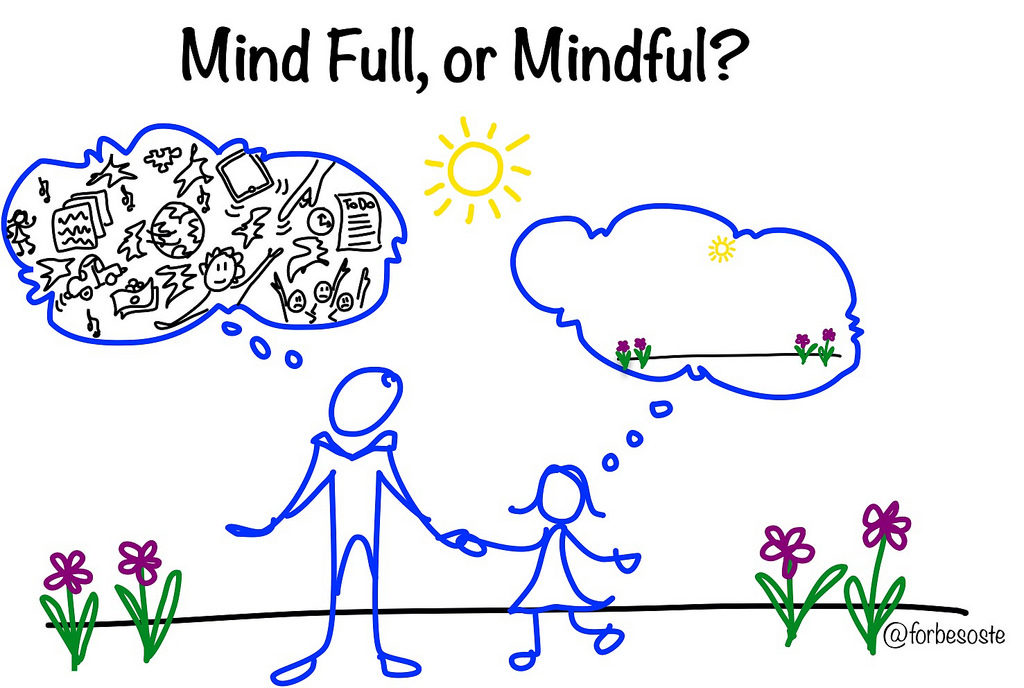by Louise Brace
Distractions, distractions, distractions. In the 21st century office, we are surrounded by them. Smart phone ringing, email pinging, tweets calling for our attention.
For most of us, it’s near impossible to stay focused; we are in what is known as ‘continuous partial attention’. Our mind is rarely focused on one task, or one person, at any one time. We are no longer fully present. And it’s stressful, right?
We start the day with enough energy to raise the titanic, but within a couple of hours, we are flagging? These distractions are impacting heavily on our performance. Our attention diminishes, as does our ability to complete even the simplest of tasks.

Let’s welcome to the stage… Mindfulness.
The most effective interactions occur when we have no distractions. No pinging, no ringing. If we are in a meeting, we are present in that meeting. If we are writing an article, we are writing and not checking emails (Louise, stop checking emails and Twitter…!)
Learning how to focus isn’t easy, but it’s one of the most important lessons we absolutely MUST learn, if we want to be successful in work and life. Mindfulness techniques can help us focus, feel less stressed, solve problems faster and feel happier.
What is Mindfulness?
Mindfulness-based Stress Reduction Training was founded in the United States back in the 1970s by Jon Kabat-Zinn. Although the origin of Mindfulness, which means moment-to-moment awareness, can be found within the Buddhist tradition.
Much research and study has been made on the subject. This isn’t just a passing holistic fad of the 21st century. Mindfulness is a technique that has decades of positive research behind it. Scientific research has proved that Mindfulness is effective in managing stress and developing positive feelings and happiness.
Mindfulness is all about living in the present, achieving focus and clarity in our daily lives. When you are totally aware of your surroundings and your full attention is in the present, you are in, what is known as, the ‘Being’ state of mind. You make every minute, every second count.
This awareness and being goes a long way towards decreasing stress and anxiety. As humans, we are more successful when we are able to manage stress. Mindfulness training helps us to see, what we might normally consider to be a problem, with a different viewpoint and to see a solution more easily. This in turn helps alleviate stress.
Read on: An article about Mindful Leadership
The science – bear with me…

Our brain has an area called the Hippocampus. It’s the part of our brain responsible for memory, learning, emotion, compassion, introspection and self-awareness. In a series of tests, carried out on participants during a Mindfulness program; MRI Scans were done to measure the grey matter of the Hippocampus. In participants who had taken Mindfulness training, the grey matter of the Hippocampus was said to increase. Similarly, the grey matter in the area known as Amygdala, which is responsible for stress and anxiety, was shown to decrease.
Mindfulness study on a Startup team
I read an article on Mindfulness in the Huffington Post about a similar study carried out by the MBSR (Mindfulness-based Stress Reduction) program at the University of Massachusetts medical school, on a high-stress startup team. The study showed how it’s possible through mindfulness practice, to diffuse high-stress situations and engage coworkers who feel emotionally out-of-touch.
The study measured typical left-to-right activity ratios when the participants were at rest. This ratio is said to predict – moderately well – our day-to-day mood range. When we have good or bad days, our ratios tip to the left or to the right. Our state of mind plays a big part in the results. In extreme cases, people who tend to tip to the far right, are more likely to feel depressed or anxious, even clinically so. And those who tip to the left, are more able to bounce back from problematical situations.
The team underwent training and were given Mindfulness exercises to practice on a daily basis for eight weeks. Before the training and eight week exercise program the participants showed a significant tilt to the right. They were working long hours and stressed to breaking point. Yet after their eight week program, they showed a positive tilt to the left. All participants agreed that they felt happier after the training, they remembered what they loved about their jobs and why they got into their specialized field.
How can Mindfulness help organizations?
Well for starters, it can save companies A LOT of money! The American Institute of Stress calculated a staggering $300bn spent every year covering absenteeism, poor performance, employee turnover, accidents and stress-related workers compensation claims. And the problem is not limited to the US, in the UK an estimated 11 million pounds is lost each year on work-related stress, depression and anxiety cases. And I am sure if I look further, I’ll find the same problem in most first world countries.
The Mindfulness At Work organization break it down into three areas:
Thinking: Mindfulness helps to build teamwork, sparks creativity and innovation, and improves communication channels between peers and managers. When you awaken to someone else’s point of view, you also open up to new ways of problem solving.
Doing: Mindfulness training in the workplace, supports our need to solve problems, to be more productive and creative. To be responsive over reactive and to stay objective. It also supports a harmonious, yet competitive team environment, whose common goal is success.
We have already identified that happy people are more engaged and motivated; this creates an immense value for organizations. Less expenditure on poor health and sickness, and more revenue generated through increased productivity.
Being: When you adopt Mindfulness, you will experience greater clarity of thought, which leads to improved creativity and greater emotional strength. We also learn to cooperate more effectively with coworkers and this stops the the feeling of powerlessness. When we work together in a team, we feel less stress and less fatigue. We bounce off the energy of others.
According to Mindfulness at Work, the technique is clinically proven to help people build all of these resources
Testimony to the success of Mindfulness in the workplace, is seeing organizations such Google, Deutsche Bank, Yahoo and Apple, embracing Mindfulness training to improve employee wellbeing and motivation.
Mindfulness exercises we can use at work
There are organizations all over the world, who work with companies to introduce Mindfulness programs to their teams. However, if you want to first experiment with some practices on your own, or with your team, to test the benefits; here’s some exercises that don’t cost a great deal, but can be extremely effective:
Give yourself feedback
A great daily Mindfulness exercise is to get both you and your team thinking about their role within the organization and how engaged they feel. Ask them to give themselves feedback on questions, such as:
- What did I do today to improve communication with my manager and peers?
- What actions did I take today to learn and grow?
- Whom did I thank today, and who recognized me?
- Was I mindful today of our company’s long-term goals?
- How engaged was I at work today?
- And your question to yourself might be: What did I do today to improve communication with my team?
10 Seconds of Gratitude and Altruism
Feeling grateful and caring about our coworkers and in general those around us, is a great technique to get us focused back to the present, and to appreciate teamwork and collaboration.
Matthieu Ricard, a biochemist turned Buddhist monk suggests that we take just 10 seconds a day to consider those around us and give silent gratitude for their health, happiness and wellbeing.
Mindfulness Affirmations
Personal affirmations remind us to be ‘mindful’. They make us stop and think about what we want in life and they are way of saying, “Hey I deserve this, I am good enough”.
I have a series of personal affirmations that I use on a daily basis to bring my awareness to what I can and want to achieve. They help take me to a state of mind that tells me, success is possible.
Personal affirmations, should be just that, personal to the individual. A good exercise is to ask your team what they want to achieve in your organization, and in general in their career moving forward. Ask them to jot down 2-3 affirmations that will remind them that what they want is entirely possible and get them to spend 10 minutes a day saying these affirmations over in their mind.
My personal affirmations are:
- I possess the qualities needed to be successful
- Creative energy surges through me and leads me to new and brilliant ideas
- I am the architect of my life; I build its foundation and choose its contents
Mindfulness Meditation
The practice of Meditation, which focuses on one’s breathing, is one of the most successful techniques for getting our minds back to the present and to stop our attention from wandering.
Ebay have special meditation rooms for their employees, and whilst it’s not feasible for the majority of us to set up meditation rooms; there’s no reason why we can’t organize regular meditation sessions for employees, teaching them the technique.
How Mindfulness was introduced in Silicon Valley
Finally, a whole chapter in the book, Contemplative Practices in Action, is devoted to how Silicon Valley leaders introduced Mindfulness practices, which they learnt during a seminar called Spirituality for Organizational Leadership.
- Start your day with a contemplative morning practice such as meditation.
- Before entering the workplace, remind yourself of your organization’s purpose and your commitment to your vocation.
- Throughout the day, pause to be fully present in the moment before undertaking the next critical task
- Review the day’s events at the close of the day, to prevent work stresses from spilling into your home life
- Before going to bed, engage in some spiritual reading
And finally: Focus takes work. If you are truly committed to following a mindful path, then all the practices in the world, won’t work, if you don’t also train yourself to switch off from technology. People can wait for your email or Whatsapp reply. Turn the ping off. While you are focused in the present, nothing else matters.
Recommended website: Mindful.org
Image credits courtesy of FlickR/Creative Commons
Mind Full vs. Mindful by Heidi Forbes Oste
It’s all in the mind by Renske Herder
Mindfulness by Lesly Juarez


Great article Louise, congratulations! I have become a firm believer that mindfulness is the way to go. I started meditating using the Headspace app and I recommend it as a good start on the road to greater mindfulness.
Thanks for the feedback and the Headspace recommendation Victoria. I will have to go and check that out. Researching and writing this article made me realise just how unfocused I can be!
Inspiring and informative. Great piece, keep up the good work.
Thanks Mattias!
Thank you for your article Louise. I am writing a speech on mindfulness, and just like writing an article, the process of researching help me learn a lot on it. I am getting a lot better on copping anxiety since I started to explore self-help materials/methods like medication. I hope my speech, through it is just a Toastmasters’ 8 mins short talk, would help my audience be aware off this method.